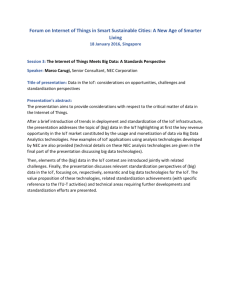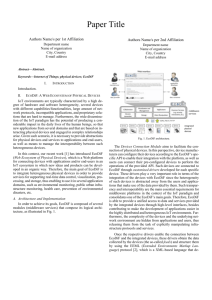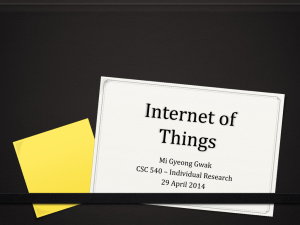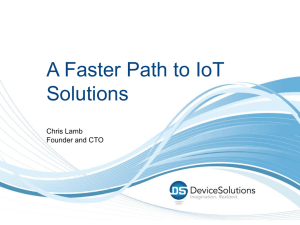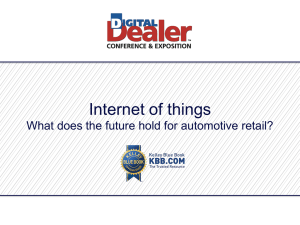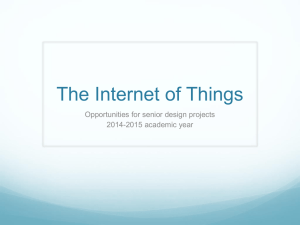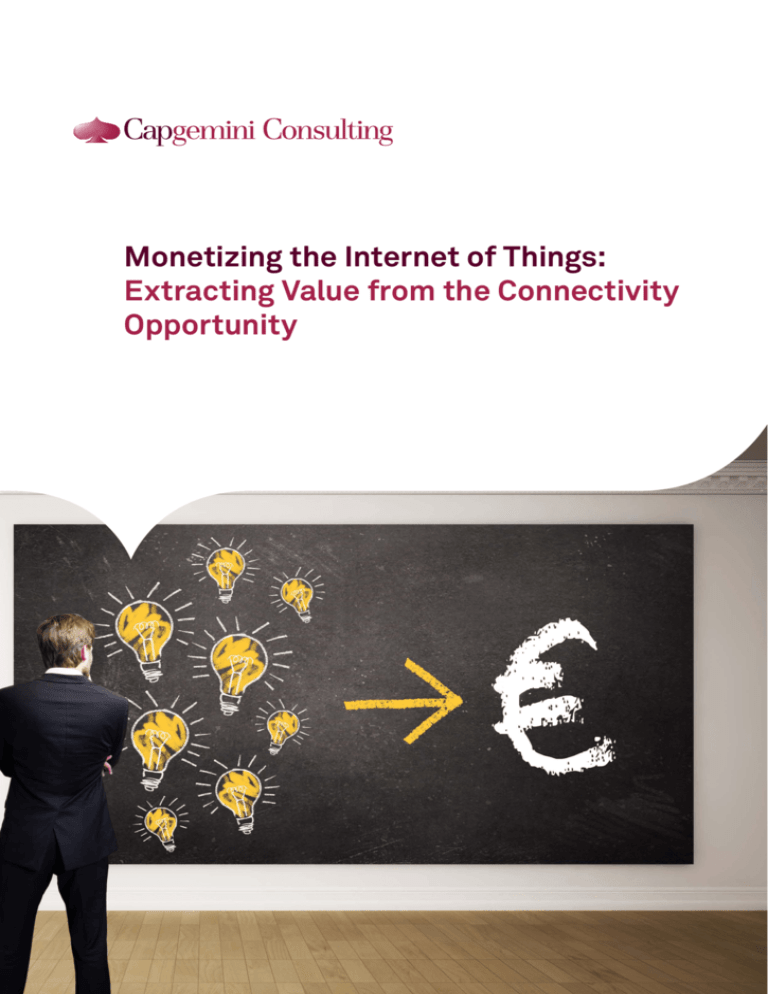
Monetizing the Internet of Things:
Extracting Value from the Connectivity
Opportunity
Why is it So Hard to Monetize the Internet
of Things?
Cisco estimates that
IoT has the potential to
generate about $19 trillion
of value over the coming
years...
Connectivity is not something that is confined
to humans. In fact, the number of connected
devices has long surpassed the number of
humans on the planet. And this machineto-machine connectivity is not limited to
a select group of super-smart devices.
Every-day objects now have sensors whose
capabilities might vary. This fundamental shift
is leading to an Internet that is far grander in
scale and opportunity than we previously
imagined. In fact, Cisco has estimated that
this Internet of Things (IoT) has the potential
to generate about $19 trillion of value over
the coming years1.
The staggering potential size-of-the-prize has
certainly caught the attention of the world’s
business community. In a recent survey of
senior business leaders around the globe,
96% said their companies would be using
IoT in some way within the next 3 years,
while 68% said their companies are already
investing budgets in IoT2. However, there is
a catch to all of this – most organizations
are yet to derive significant commercial
value from IoT. Our recent research shows
that 70% of organizations do not generate
service revenues from their IoT solutions
(see our report “The Internet of Things: Are
Organizations Ready for a Multi-Trillion Dollar
Prize?”, 2014)3.
We have looked at why organizations are
falling short in monetizing the IoT, and see
a combination of external and internal
challenges (see Figure 1).
… But there is a
catch. Over 70% of
organizations do not
generate service revenues
from their IoT solutions.
Figure 1: Monetization Challenges for the IoT
Security and
Privacy Concerns
Hinder Consumer
Adoption
Key IoT
Monetization
Challenges
Lack of
Standards
Limits Revenue
Potential
Source: Capgemini Consulting analysis
2
Successful
Monetization
Demands Significant
Investments in Acquiring
New Capabilities,
Often without Clear Returns
Security and Privacy Concerns
Hinder Consumer Adoption
Lack of Standards Limits Revenue
Potential
The IoT creates an intertwined mesh
of systems and devices, which hugely
complicates issues of information security.
“Hacks” or attacks can happen at multiple
levels. They might be targeted at the device
itself, or they can be carried out over the
communication network over which the
data is transferred. The recent example of
a “hacked refrigerator” highlights both the
nascent nature of this sphere of technology
and the significant security issues. As part
of a large-scale hack attack over a number
of weeks, more than 750,000 malicious
emails were sent from more than 100,000
everyday consumer devices, including –
astonishingly – one report of a refrigerator4.
Customers today are increasingly aware
of these sorts of dangers. A recent survey
showed that 69% of respondents were
concerned that a connected appliance
could result in data breach of sensitive
information5. These issues are a significant
challenge to the consumer adoption of IoT
offerings.
IoT solutions deliver the most value when
they are connected to a web of interlinked
services. For instance, a smart home
solution can deliver significant value only
when it integrates the electrical, safety
and surveillance systems. However,
our research indicates that only 13%
of organizations offer IoT solutions that
integrate with third-party products and
services (see our report “The Internet of
Things: Are Organizations Ready for a
Multi-Trillion Dollar Prize?”, 2014)6. This
prevents companies from tapping into a
larger ecosystem of products and services,
and significantly limits revenue enhancement
opportunities. Unless standards are agreed
upon – spanning industries, vendors and
products – the potential of the IoT will remain
under-exploited.
A recent survey indicated
that 69% of respondents
were concerned that a
connected appliance could
result in data breach of
sensitive information.
Successful Monetization Demands
Significant Investments in Acquiring
New Capabilities, Often without
Clear Returns
Most product-centric organizations
need to make significant investments
in acquiring new functional capabilities,
before they can sell IoT-based services.
For instance, organizations need to
augment their product management
capabilities with the skills needed to
develop and market services. Moreover,
since connectivity reduces the time lag
between the occurrence of an event and
the time taken for information to reach
the support center, customers are also
likely to expect faster response times.
As such, specialized customer support
teams need to be set up to respond
rapidly to customer queries in real-time.
Acquiring and building these additional
capabilities entail significant effort and
investment, often without a clear return
on investment in the short-term. These
factors delay monetization efforts.
96% of companies will
be using IoT in some way
within the next three
years.
It is pertinent to note that these are very
early days in what is still a very fastdeveloping and immature marketplace.
We have tried to capture some initial
observations on monetization in the
coming sections.
Only 13% of
organizations offer IoT
solutions that integrate
with third-party products
and services.
3
How Can Organizations Profit from the IoT?
On the conventional Internet, many of
the current leading players have seen
two broad phases – phase 1 where they
focused on traction, and a second phase
where they focused on monetization.
On the Internet of Things though, most
startups and incumbents are actively
looking at monetization models right
from the start. While these are still early
days, there are four distinct models that
are emerging (see Figure 2).
Product Selling is an Organization’s
Entry into the IoT World
“Hardware Premium” is the most basic
form of monetization model. Here,
organizations add connectivity options
to an existing or new product and offer
remote device management in the
form of mobile apps. This basic level
of connectivity and control enables
organizations to charge a premium for
their product.
An example of this model is LIFX (see
Figure 3), which produces remotely
programmable LED light bulbs that can
be controlled through a smart-phone
app. These bulbs are sold at a premium,
and are priced around 10 times higher
than a compact fluorescent bulb7.
Product selling is an
organization’s entry into
the IoT world.
From a consumer perspective, a key
driver for buying hardware premium
products is the novelty factor involved in
controlling hitherto standalone devices.
Figure 2: Monetization Models for the IoT
Ecosystem Building
Simplest model where
organizations charge a
price-premium for the
product’s connected features
Ex: LIFX, a remotely
programmable LED light bulb
controlled by a smartphone app
Collaborative
Service
Revenue
Relational
Hardware Premium
Relationship with Customer
Ex: SmartThings sells its
own products and services
while creating a platform for
other IoT companies to sell
services that interlink with it
In this model, organizations
convert what has been a
traditional product into a
service by tying in a recurring
pricing model for specific features
Data
Revenue
In this model organizations
generate revenues by selling
packaged data gathered from
sensors
Hardware
Premium
Ex: Michelin Solutions packages
insights generated from the data
that it gathers through sensors
embedded inside customer vehicles
Basic
Advanced
Complexity of IoT Monetization Model
Source: Capgemini Consulting analysis
4
Ex: Volkswagen’s “Car-Net”
service offers security features,
maintenance assistance and
navigation tools for a set
subscription fee
Data Revenue
Transactional
In this model, organizations
create a platform where they
ideally make money from both
other product vendors and
end consumers
Service Revenue
Ecosystem
Building
Figure 3: LIFX Bulb and Smartphone App
Service Bundling Generates
Recurring Revenues through LongTerm Customer Relationships
The service model offers a recurring
revenue stream and, more importantly,
creates a relationship with the customer
long after they have purchased a
product.
For example, Volkswagen’s “Car-Net” service
offers security features, maintenance assistance,
and navigation tools for its customers for
a subscription fee of $17.99/month and
$199/year (see Figure 4). Customers can
also select from several features – for
example, automatic crash notifications
can be sent to chosen contacts when
airbags are deployed in the vehicle8.
Source: Apple App Store listing of LIFX app
Figure 4: Volkswagen’s Car-Net Service
Similarly, in the B2B segment, smart
thermostat manufacturer Nest is using its
Learning Thermostat — a home automation
and energy management product — as
a platform to offer energy management
services to utilities. Nest charges utilities $30
to $50 per thermostat annually for its service.
As part of the service, Nest helps utilities
better understand their customers’ energy
usage. Nest automatically reschedules
usage of equipment with high electricity
consumption such as air conditioners. By
doing so, it has been able to reduce overall
electricity requirement by as much as 50%
in peak times thus saving significant money
for utilities. Nest is currently installed in over 1
million homes and close to 20 utilities have
signed up for the service9.
Service bundling enables
organizations to create
long-term relationships
with the customer.
Source: Company website
5
Building a Smart Home, using the Ecosystem Model – SmartThings
Source: Company website
SmartThings is an Internet of Things startup that offers a centralized hub and an assortment of both in-house and third-party
IoT products. The company was launched in 2012 and raised over $1.2 million on Kickstarter (a crowdfunding platform) within
18 months. The company has a smartphone app that is used to control its hub and all of its connected devices. It offers broad
guidance to developers who want to make products for its platforms offering them design guidelines. The hub is priced at $99.
Various products that the company sells as part of the platform include locks, switches, environment sensors, alarms among
others. SmartThings works with partners such as Belkin, Sonos, and Philips, and on operating systems such as Android and
iOS. Over 1,000 devices and 8,000 applications have been made till August 2014 when the company was acquired by Samsung
Electronics for approximately $200 million.
Source: CNET, “Samsung snaps up SmartThings, embracing Internet of Things”, August 2014
Data Generated in the IoT Offers a
Monetization Model
IoT devices generate large volumes of
sensor data. For many organizations, the
ability to capture, package and sell this
data offers a potential monetization model.
Once this data has been aggregated and
anonymized, organizations can choose
to sell it raw, package insights from it or
monetize it using advertizing.
For instance, Michelin, through its Michelin
Solutions unit, packages insights generated
from the data that it gathers through
sensors embedded inside customer
vehicles. Customers pay Michelin on a pervehicle, per-year basis.These insights help
its customers achieve a variety of goals
including reducing costs, carbon footprint,
among others10.
6
Ecosystem Building Allows
Monetization from Dual-Sided
Markets
The IoT thrives in a connected ecosystem
– the bigger the ecosystem, the greater is
the value generated for all stakeholders.
In an ecosystem, the focus is not on
selling a product or a service, but on
providing a shared platform to other
players in the ecosystem – hardware
manufacturers, software developers,
service providers and the like. In such
a model, the platform promoter ideally
makes money from both end customers
as well as other platform users. Platform
users pay the promoter for listing and the
promoter also gets a share whenever a
product is sold to the end customer on the
platform. A shared platform brings multiple
benefits to participants. For instance,
with the APIs provided by the platform
provider, independent companies that
have IoT products/services can develop
custom applications. SmartThings is an
example of a company that has taken the
ecosystem building approach towards a
monetization model (see insert).
An Ecosystem model
allows organizations
to generate value for
multiple stakeholders
– customers and other
platform partners.
Multiple Pricing Models Enable Companies to Realize the Full Benefits
of IoT Monetization
Pricing Model
Example
One-time Charges: Customer pays a one-time price for purchasing
the offering
Sells health-tracking wearable
devices for one-time cost
Pay-For-Results: Allows customers to pay only for realized results
from the IoT offering
Recovers payments as percentage
of savings obtained from service
Freemium: Allows organizations to attract customers that are
not convinced of the value of the offering
Subscription: Offers customers the flexibility to customize service
options and duration of the service
Monetization Model
Hardware Premium +
Service/Data Revenue
Uses a freemium model for
industrial IoT services
Monthly subscription for remote
security and energy management
Service/Data Revenue
Pay-As-You-Go: Allows customers to pay according to the actual
usage of the service
Sells pay-per-mile auto
insurance
Source: Capgemini Consulting analysis
For each IoT monetization model, we see a variety of pricing models that can be adopted.
Pricing Models for Products and Services
For One-Time Charges, the customer pays a one-time price for purchasing the offering. This model is largely used with products,
though it can be used with services too. A Subscription Model offers customers the flexibility to customize service options and
the duration of the service. A Pay-As-You-Go Model allows the customer to pay according to the actual usage of the service.
The Pay-for-Results Model allows customers to pay only for realized results from the IoT offering – a strong value-based model
where the customer can see the RoI directly. For instance, IoT startup Enlighted builds devices that can detect heat, light, and
motion, and pairs them with a software system that can control lighting, heating and cooling based on the data these sensors
collect. Customers pay Enlighted a percentage of the money the technology saves them each month, without paying anything
up-front. Freemium Models allow organizations to attract customers that are not convinced of the value of the offering.
Pricing Models for Ecosystems
Ecosystem pricing models typically tend to be different from those of product and service models. A Fixed Fee Model is one
where customers pay a fixed fee for using the platform. A Transaction-Based Fee is charged by the platform provider for every
transaction carried out over the platform. In a Revenue Share Model, customers pay a share of their revenues to the platform
provider in exchange for using the platform services.
Source: Wired, “The Startup That Lowers Your Energy Bills by Paying for Upgrades”, August 2014
7
One Size Does Not Fit All – Which Monetization
Model Works, And For Whom?
There is no neat one-size-fits-all monetization
model for the IoT, not least because the
needs of different companies vary hugely.
Here, we look at various business scenarios
and recommend the monetization model
suitable for each (see Figure 5).
Adding connectivity
and sensors to existing
products is a quick way
for organizations to
partake in the benefits of
the IoT opportunity.
A “Hardware Premium” Model is
Ideal for Companies that Want to
Differentiate Themselves from their
“Disconnected” Competition
The IoT enables organizations to
add connectivity and remote device
management to traditional products. For
traditional manufacturers, a quick way of
partaking in the IoT opportunity is to add
sensors and software to their traditional
products, increasing their overall value to
consumers.
For instance, Philips Hue light series are
an expensive set of connected bulbs
for the home. The starter kit costs $200
for three bulbs and a hub. These lights
can change colors in real-time and be
programmed directly through a smartphone
application11. The success of this model
hinges on how much value organizations
can add over and above a traditional
product. Customers need to see the
value in the premium that an organization
charges. A typical way of ensuring that is
to make connectivity features accessible
through a variety of platforms including
web and mobile, as we have seen in the
case of the LIFX bulbs.
Products that Have High Customer
Engagement are Good Targets for a
“Service Bundling” Model to Unlock
New Revenue Opportunities
Products that have high customer
engagement, such as cars with infotainment features and smartphones, can
be used to establish a recurring revenue
stream by adopting a service bundling
model. A straightforward way to establish
these streams is to offer basic services
free of cost (adopting a “freemium”
model). This helps build familiarity
and provides inputs for improving and
customizing the service. The advanced
functionalities can then be made
available for a price. It is also important
to create differentiated offerings based
on functionality and price; this gives
customers the flexibility to choose the
offering best suited for them.
Existing examples of this monetization
model include On Star Corporation and
Volkswagen Car-Net. These offerings
provide a range of services comprising
security features, maintenance assistance,
and navigation tools. A key success factor
for bundles is to ensure that organizations
constantly improve their service portfolio,
in order to keep pace with more advanced
services that competitors might offer.
The success of the
“Hardware Premium”
model hinges on how
much value organizations
can add over and above a
traditional product.
Figure 5: Monetization Models and Their Applicability
Monetization Model
Critical Success Factors
Hardware companies that want to differentiate
themselves
Enhanced value delivered over traditional product
Hardware Premium
Service Revenue
Companies having products with high customer
engagement
Having multiple subscription options at varying
price points, including free
Data Revenue
Companies that are in a position to collect
significant data from their customers
Managing customer privacy and staying
compliant to regulations
Ecosystem
Companies that have a wide range of IoT
products
Ensuring the platform is equitable to all
stakeholders and not just platform promoters
Source: Capgemini Consulting analysis
8
Target Companies
Organizations that are in
Possession of Significant Customer
Data Stand to Benefit from a “Data
Revenues” Model
The data revenue model is ideally
suited for organizations that have
built a large customer base and are
in a position to use sensors to collect
significant customer data. The idea is
that organizations need not necessarily
offer a product or a service to generate
revenues from the IoT. They can sell
the data by packaging it or by adding
a layer of advertising on top. A critical
challenge with this model revolves
around customer privacy and the need
to obtain prior consent before using the
data and abiding to local regulations.
Companies that have a Diverse
Portfolio of Products Should Adopt
an “Ecosystem Building” Model
Organizations that have a wide range
of products that will collectively benefit
from the IoT should create scalable and
easy-to-use platforms. These platforms
in turn will enable other organizations to
leverage “hardware premium” and “service
bundling” monetization models for IoTenabled offerings. The core premise for
the model is that by creating a platform,
the company can unlock synergy
possibilities that were previously hidden. For
instance, SmartThings built the tools that will
make it easier for developers to integrate their
devices with its platform. It also offered ongoing
support and comprehensive documentation
to encourage developer adoption. The result
- SmartThings has been able to create a
community of 5,000 developers that use its
open platform12. Consequently, 1,900 new
devices and 2,300 new apps featured on its
platform in a span of 90 days13.
once organizations do arrive at a recipe for
extracting profitable value from the IoT, the
rewards of a connected world will certainly
be worth the wait.
As the number of partnering organizations
increases, these platforms evolve into
ecosystems and foster collaboration
among partners. These ecosystems are
also a source of valuable data regarding
customer preferences, which can then be
further monetized. Success in this model
is contingent on a clear and strong value
proposition for all stakeholders, and not
just the platform owner.
The Internet of Things is a hugely exciting
phenomenon. It has the potential to create
a world where everything is connected
– a new age of connectivity. While there
are numerous agile start-ups emerging
from this fertile ground, the IoT offers an
unprecedented opportunity for traditional
organizations as well. Clearly, we are at
the phase where successful monetization
is still a challenge for many. However,
9
References
1
Washington Post, “Cisco CEO at CES 2014: Internet of Things is a $19 trillion opportunity”, January 2014
2
PSFK, “A Brief History Of The Internet Of Things”, March 2014
3
Capgemini Consulting, “The Internet of Things: Are Organizations Ready for a Multi-trillion Dollar Prize?”, 2014
4
Proofpoint, “Proofpoint Uncovers Internet of Things (IoT) Cyberattack”, January 2014
5
Fortinet, “Connected Home Survey”, June 2014
6
Capgemini Consulting, “The Internet of Things: Are Organizations Ready for a Multi-trillion Dollar Prize?”, 2014
7
Wired, “App-controlled LIFX bulbs reinvent the humble household light”, September 2012
8
Company website
9
EDF, “Nest’s Promising Results for Reducing Peak Electricity Demand”, May 2014
10 Company website
11 Company website
12 Forbes.com, “SmartThings Wants To Eviscerate The Home Insurance Industry”, July 2014
13 Yahoo Finance, “SmartThings Sweetens its Hub for Consumers and Developers in a Bid to Own the Smart Home”, May 2014
10
Authors
Didier Bonnet
Senior Vice President
didier.bonnet@capgemini.com
Jerome Buvat
Head of Digital Transformation
Research Institute
jerome.buvat@capgemini.com
Subrahmanyam KVJ
Manager, Digital Transformation
Research Institute
subrahmanyam.kvj@capgemini.com
Digital Transformation
Research Institute
dtri.in@capgemini.com
The authors would also like to acknowledge the contributions of Menno Van Doorn, Research Director VINT, Sogeti Netherlands,
Jaap Bloem, Research Principal VINT, Sogeti Netherlands, and Rick Bouter from Sogeti Netherlands.
For more information contact
Germany/Austria/Switzerland
Guido Kamann
guido.kamann@capgemini.com
France
Cyril Francois
cyril.francois@capgemini.com
Netherlands
Albert Wiggers
albert.wiggers@capgemini.com
Spain
Christophe Jean Marc Mario
christophe.mario@capgemini.com
Sweden/Finland
Karl Bjurstrom
karl.bjurstrom@capgemini.com
United States
Stephen Pumphrey
stephen.pumphrey@capgemini.com
United States
Jeffery T Hunter
jeffrey.hunter@capgemini.com
About Capgemini and the
Collaborative Business Experience
Capgemini Consulting is the global strategy and transformation
consulting organization of the Capgemini Group, specializing
in advising and supporting enterprises in significant
transformation, from innovative strategy to execution and with
an unstinting focus on results. With the new digital economy
creating significant disruptions and opportunities, our global
team of over 3,600 talented individuals work with leading
companies and governments to master Digital Transformation,
drawing on our understanding of the digital economy and
our leadership in business transformation and organizational
change.
With more than 130,000 people in over 40 countries, Capgemini
is one of the world’s foremost providers of consulting,
technology and outsourcing services. The Group reported 2013
global revenues of EUR 10.1 billion. Together with its clients,
Capgemini creates and delivers business and technology
solutions that fit their needs and drive the results they want. A
deeply multicultural organization, Capgemini has developed its
own way of working, the Collaborative Business ExperienceTM,
and draws on Rightshore®, its worldwide delivery model.
Learn more about us at www.capgemini.com
Find out more at: www.capgemini-consulting.com
Rightshore® is a trademark belonging to Capgemini
Capgemini Consulting is the strategy and transformation consulting brand of Capgemini Group. The information contained in this document is proprietary.
© 2014 Capgemini. All rights reserved.


